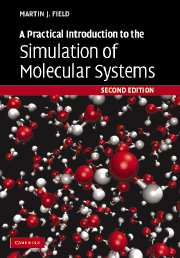Book contents
- Frontmatter
- Contents
- Preface to the first edition
- Preface to the second edition
- 1 Preliminaries
- 2 Chemical models and representations
- 3 Coordinates and coordinate manipulations
- 4 Quantum chemical models
- 5 Molecular mechanics
- 6 Hybrid potentials
- 7 Finding stationary points and reaction paths on potential energy surfaces
- 8 Normal mode analysis
- 9 Molecular dynamics simulations I
- 10 More on non-bonding interactions
- 11 Molecular dynamics simulations II
- 12 Monte Carlo simulations
- Appendix 1 The pDynamo library
- Appendix 2 Mathematical appendix
- Appendix 3 Solvent boxes and solvated molecules
- Bibliography
- Author index
- Subject index
5 - Molecular mechanics
Published online by Cambridge University Press: 03 December 2009
- Frontmatter
- Contents
- Preface to the first edition
- Preface to the second edition
- 1 Preliminaries
- 2 Chemical models and representations
- 3 Coordinates and coordinate manipulations
- 4 Quantum chemical models
- 5 Molecular mechanics
- 6 Hybrid potentials
- 7 Finding stationary points and reaction paths on potential energy surfaces
- 8 Normal mode analysis
- 9 Molecular dynamics simulations I
- 10 More on non-bonding interactions
- 11 Molecular dynamics simulations II
- 12 Monte Carlo simulations
- Appendix 1 The pDynamo library
- Appendix 2 Mathematical appendix
- Appendix 3 Solvent boxes and solvated molecules
- Bibliography
- Author index
- Subject index
Summary
Introduction
In the last chapter we discussed quantum chemical methods for calculating the potential energy of a system whereas in this chapter we present an alternative class of approaches, those that use empirical energy functions. To start, though, a point of notation will be clarified. Several different terms are employed to denote empirical energy functions in the literature and, no doubt, inadvertently, in this book. Common terms, which all refer to the same thing, include empirical energy function, potential energy function, empirical potential and force field. The use of empirical potentials to study molecular conformations is often termed molecular mechanics (MM).
Some of the earliest empirical potentials were derived by vibrational spectroscopists interested in interpreting their spectra (this was, in fact, the origin of the term ‘force field’), but the type of empirical potential that is described here was developed at the end of the 1960s and the beginning of the 1970s. Two prominent proponents of this approach were S. Lifson and N. Allinger. These types of force field are usually designed for studying conformations of molecules close to their equilibrium positions and so would be inappropriate for studying processes, such as chemical reactions, in which this is not the case.
Typical empirical energy functions
This section presents the general form of the empirical energy functions that are used in molecular simulations. A diversity exists, because the form of an empirical potential function is, to some extent, arbitrary, but most functions have two categories of terms that deal with the bonding and the non-bonding interactions between atoms, respectively. These will be discussed separately.
Information
- Type
- Chapter
- Information
- Publisher: Cambridge University PressPrint publication year: 2007
